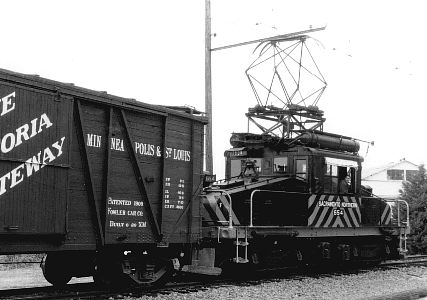RIDING THE SIX-FIFTY-FOUR WITH LES PAUL
Ohmer Hill, where the North Concord-Martinez BART station is now located, was an operational headache for Sacramento Northern freight trains. Frequently freight trains headed south from Port Chicago to Oakland would have to double, triple, or even quadruple over this hill, which means the train would break up into two, three, or four sections to get over the hill. Cars would be "set out", or accumulated at Concord Station until the entire train could be reassembled for its journey on to Oakland.
On one particular occasion while doubling Ohmer Hill, locomotive or motor 654 with Les Paul as the motorman-engineer brought four boxcars to Concord and was returning to Ohmer for the rest of the train. Les Paul stopped 654 where I was standing and said, "Hey, Red! Want to go for a ride?" Of course I responded, "Sure!" I climbed aboard and went into the cab to sit on the seat on the opposite side of the motor, as the brakeman was riding outside on the deck, taking advantage of the warm spring weather. It was about 1953, and I was 15 years old.

Going from Concord to Ohmer the control handle was not advanced beyond half-way, and the motor rocked gently along at a leisurely 20 miles per hour. I looked at all the control gauges and meters in front of me, taking note of the voltmeter which registered above 1000 volts on the 1500 volt overhead wires.
We crested Ohmer Hill, and some distance beyond Highway 4 stood the rest of the train with Baldwin-Westinghouse motor 660 as the pusher behind the caboose. Les Paul was grumbling that 654 did not slip and he felt they could made it over the hill without doubling. Mr. Hutchins, the motorman-engineer on the pusher, had applied the air brakes so that doubling the hill would take longer, as they were on overtime.
As we approached the remainder of the train, Les Paul had me move to a seat cushion atop a tool box, so I wouldn't go sprawling onto the floor in case he hit it too hard while coupling. What floor? You couldn't see the floor as there was so much conduit and piping. It was hard to find something to put your feet on.
The 650 class were favorites with the crews, due to a smaller cab which provided a more central location for the the controls and offered a better view both fore and aft. They were also quieter in operation than their counterpart Baldwin-Westinghouse motors. Motor 654 was built by General Electric in 1928, but for some reason was not delivered until March 1930, and carries "Built 3-30" on its builder's plate. It was part of a group of five motors, 650 through 654. Motors 650 and 651 were built in 1923; 652 and 653 were built in 1928. Motor 654 weighed 126,640 lbs. and had 820 horsepower.

After the coupling was made and the train started up Ohmer Hill towards Concord, Les Paul told me to get back up on the seat at the window opposite from him. The train crawled at a slow walk up the hill with Les Paul giving the motor just enough juice to keep the wheels moving. He kept one hand on the controller, the other on the sanders, and an intent eye on the ammeter. He was trying to keep from spinning the wheels which would have brought the train to a halt. Conserving the sand was a necessity, as these electric locomotives did not have a large sand capacity. In previous years, a 55-gallon drum of extra sand was carried on the outside deck outside.
After cresting Ohmer Hill, I wasn't quite prepared for what happened. Les Paul opened the controller all the way and "let her go" down the hill. We must have been doing 40 or 50 miles per hour at the bottom going across the flat at Olivera Road headed for Maltby Hill and Concord station. Motor 654 went into all kinds of gyrations, rocking back and forth while the front end nosed alternately to the right and left. I've never ridden a train quite like that since. I believe I was either "being taken for a ride" or Les Paul was showing off! I asked him how fast 654 would go. He thought for a moment and said about 40 miles per hour. The speed limit for freight trains on the SN was 30 miles per hour, and 20 through Concord city limits.
Les Paul was my favorite motorman as he was quite outgoing and always hollering at me, even on days when the train didn't stop in Concord. If I was close, he would give me a hearty "Hi Red". Les Paul was quite nonchalant, usually riding seated on the cab arm rest with his feet on the seat and holding onto the controller handle to keep from falling out. Yes, this was the way we went down Ohmer Hill! But Les Paul was the most talented of the SN motormen, and was quite comfortable with his work. The other motormen, former San Francisco-Sacramento or Oakland, Antioch & Eastern men, were all quite businesslike, saying "Let's get going," or "Get this train over the road." Les Paul was more relaxed and never in a hurry.
Ohmer Hill, sometimes called Williams Cut, got its name due to Oakland & Antioch passenger cars being equipped with Ohmer fare registers. The idea was to ring up fares while the train was going uphill. Then the conductor could walk downhill as he moved from the front to the rear of the car. That's the truth.
Mr. Jory bought his dairy ranch at Ohmer in 1912, and changed the name to Omar Farms, for what reason his daughter Evelyn Jory Boyd doesn't know. The railroad kept the name Ohmer so as to not have to change the name on tickets and timetables.


